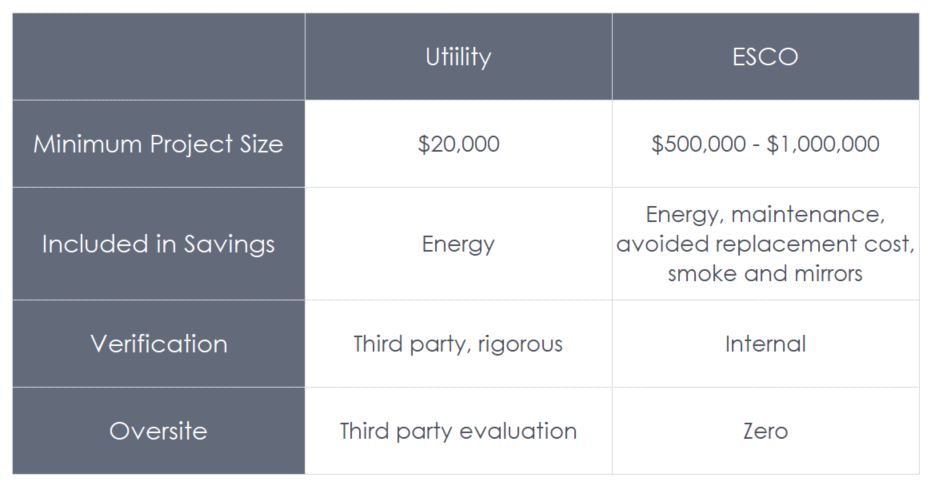Last week’s post about utility innovation and the need for legislative reform for a modern grid was a big hit. Thank you. This week, as promised, I will advance the discussion to provide some ideas for modernizing legislation and utilities to catch up with the times.
Smart Thermostats
Since the heating season has begun in earnest, it was time to get a smart thermostat for my “new” home. My second Nest thermostat just arrived. I rushed home, leaving the office at 6:00, and by 6:45, I had the old thermostat removed, the Nest installed, connected to wifi, loaded on my phone, and ready to go – a micro miracle!
Anyone reading this without a wifi-connected thermostat should be… something. I won’t say. It’s the cat’s meow. For instance, in commercial buildings “optimal start,” the time at which heat needs to be turned on full blast to be warm when occupants arrive, has been a farce for decades.
In my house, I manually guessed when to start heating and quickly realized, this is stupid. I would instead let Nest do optimal start for me through its “true radiant[1]” option. It works well, and I look forward to observing how it fine tunes with time.
See the Utility Store below, and consider the value that could be added to customers through smart thermostats. They have a ton of options and a ton of capability, but I am here to tell you, navigating it all for maximum value requires an energy expert.
Commercial and Industrial Engagement
Gee wiz, now that I think of it, what I just described for homes is precisely what we did for commercial and industrial customers in a utility pilot almost 15 years ago! The utility would provide customer-specific energy-benefit to cost analysis, finance the deal, guarantee positive cash flow, provide third-party measurement and verification, and if desired, manage all the contractors. THAT is energy expertise and service.
What happened? The regulators ground the utility down, making it very difficult and miserable.
THIS is what needs to change. Obstinance. Compare it to a typical energy services company that guarantees positive cash flow.

Minimum Project Size
Minimum project size is driven by what else – return on customer acquisition investment. This is another thing lawmakers and regulators need to understand. It costs a lot to land a customer from scratch. Therefore, an ESCO needs a big project to cover the overhead. Not so with the utility, which should already own the long-term relationship. They can cost-effectively deliver much smaller projects for customers who are now left out of the action.
Savings
Here again, old-school thought needs to be destroyed. We are directing a cash stream away from energy consumption toward energy efficiency. IT DOES NOT MATTER to the customer what some fictional baseline equipment would consume.
Verification
If it’s a regulated program, and I would say it should be, utilities can use third-party M&V experts for assurance that they won’t get whacked during evaluation – even though evaluation is getting weaker all the time.
Oversite
Finally, utility programs are subject to independent evaluation; ESCOs are not.
This is a sweet deal for everyone involved if legislation and regulators would simply allow it to happen. The time has come.
Utility mindsets need to change too. Utilities may say:
- We don’t want to be a financing institution. Ok. The amount is tiny compared to the core business, but if desired, outsource this to banks.
- We can’t guarantee cash flow. Why not? ESCOs do all the time, and the risk is infinitesimal with decent engineering.
- We can’t do on-bill financing. Good grief. I do electronic funds transfers for $4.71 per month for satellite radio.
The Utility Store
Products and services don’t need to be limited to efficiency and demand response. Some municipalities handle all utilities – electricity, natural gas, television, telephone, water, and sewer.
My former locally owned telecom company provided cable TV over the phone lines. They also sold televisions, and I bought. Why? Because their service for everything from internet trouble to equipment problems was ultra-fast and positive. Another thing is, if something went haywire, I could go to their store and swap it out. No questions. One time my remote crapped out. I called them and walked into their store a few minutes later. They handed me a new one before I could even get a sentence out: “Hi, I just called… Oh, thank you!” Amazing!
Utilities could set up Verizon-like stores for products and services that help customers use their energy. They should have EV charging stations outside, demos of equipment including heat pumps for HVAC and water heating, chargers, window and insulation demonstrations. They could develop an online rating system like Angie’s List for products and service providers. Need something useful to tweet? How about the top rated contractors by category? It’s not you with the recommendation. It’s the customers!
Free awesome coffee.
Most of you don’t remember when shopping malls decimated downtowns. It has reversed. Downtown is cool again. Most of you aren’t aware that utilities had open office hours in every little town (and big town).
See the parallel? You don’t beat Amazon and Walmart at their game. You create a different game of engagement, expertise, and breathtaking service. It is the future.
Complain or act.
How do you make money at it? Oh, I have ideas for that!
[1] That is a bad descriptor, but Nest will have to call me for advice, and I’ll bet they will. No laugh.
